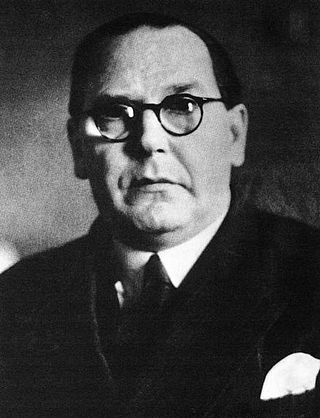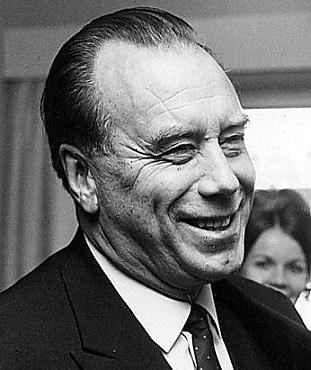Contents

| |||||
| Decades: | |||||
|---|---|---|---|---|---|
| See also: | |||||
Events in the year 1953 in Finland .

| |||||
| Decades: | |||||
|---|---|---|---|---|---|
| See also: | |||||
Events in the year 1953 in Finland .

Urho Kaleva Kekkonen, often referred to by his initials UKK, was a Finnish politician who served as the eighth and longest-serving president of Finland from 1956 to 1982. He also served as prime minister, and held various other cabinet positions. He was the third and most recent president from the Agrarian League/Centre Party. Head of state for nearly 26 years, he dominated Finnish politics for 31 years overall. Holding a large amount of power, he won his later elections with little opposition and has often been classified as an autocrat.

Juho Kusti Paasikivi was a Finnish politician who served as the seventh president of Finland from 1946 to 1956. Representing the Finnish Party until its dissolution in 1918 and then the National Coalition Party, he previously served as senator, member of parliament, envoy to Stockholm (1936–1939) and Moscow (1940–1941), and Prime Minister of Finland. He also held several other positions of trust, and was an influential figure in Finnish economics and politics for over fifty years.

Väinö Alfred Tanner was a leading figure in the Social Democratic Party of Finland, and a pioneer and leader of the cooperative movement in Finland. He was Prime Minister of Finland in 1926–1927.

The Paasikivi–Kekkonen doctrine was a foreign policy doctrine established by Finnish President Juho Kusti Paasikivi and continued by his successor Urho Kekkonen, aimed at Finland's survival as an independent sovereign, democratic country in the immediate proximity of the Soviet Union.

Osmo Antero Vänskä is a Finnish conductor, clarinetist, and composer.

The Agreement of Friendship, Cooperation, and Mutual Assistance of 1948, also known as the YYA Treaty from the Finnish Ystävyys-, yhteistyö- ja avunantosopimus, was the basis for Finno–Soviet relations from 1948 to 1992. It was the main instrument in implementing the Finnish policy called Paasikivi–Kekkonen doctrine.

Karl-August Fagerholm was a Finnish politician. Fagerholm served as Speaker of Parliament and three times Prime Minister of Finland. Fagerholm became one of the leading politicians of the Social Democrats after the armistice in the Continuation War. As a Scandinavia-oriented Swedish-speaking Finn, he was believed to be more to the taste of the Soviet Union's leadership than his predecessor, Väinö Tanner. Fagerholm's postwar career was, however, marked by fierce opposition from both the Soviet Union and the Communist Party of Finland. He narrowly lost the presidential election to Urho Kekkonen in 1956.

Tamminiemi is a villa and house museum located in the Meilahti district of Helsinki, Finland. It was one of the three official residences of the President of Finland, from 1940 to 1982. From 1956, until his death in 1986, it served as the residence of President Urho Kekkonen. Since 1987, it has been the Urho Kekkonen Museum. Tamminiemi is located in a park by the sea. Its floor area is about 450 square metres (4,800 sq ft); living quarters comprise the first two floors while the third floor is dedicated to office space.
Parliamentary elections were held in Finland on 7 and 8 March 1954.

Lilli Katriina Paasikivi-Ilves is the artistic director of the Finnish National Opera since 2013 and a mezzo-soprano.
The Note Crisis was a political crisis in Soviet–Finnish relations in 1961. The Soviet Union sent Finland a diplomatic note on October 30, 1961, referring to the threat of war and West German militarization and proposing that Finland and the Soviet Union begin consultations on securing the defence of both countries, as provided for in the Finno-Soviet Treaty of 1948. The note coincided with the detonation of the Tsar Bomba, the most powerful nuclear test in history, and followed close on the heels of the Berlin Crisis and Bay of Pigs Invasion.

Kekkonen's first cabinet was the 33rd government of Finland. The cabinet existed from 17 March 1950 to 17 January 1951. It was a minority government. The cabinet's Prime Minister was Urho Kekkonen.

Väinö Olavi Leskinen was a Finnish politician, minister and a member of the parliament from Social Democratic Party of Finland. He is perceived as one of the major Finnish social democratic politicians of the 1950s and 1960s.

The Night Frost Crisis or the Night Frost was a political crisis that occurred in Soviet–Finnish relations in the autumn of 1958. It arose from Soviet dissatisfaction with Finnish domestic policy and in particular with the composition of the third government to be formed under Prime Minister Karl-August Fagerholm. As a result of the crisis, the Soviet Union withdrew its ambassador from Helsinki and put pressure on the Finnish government to resign. The crisis was given its name by Nikita Khrushchev, who declared that relations between the countries had become subject to a "night frost".
Events in the year 1955 in Finland.
Events in the year 1956 in Finland.
Helena Maria Juntunen is a Finnish operatic soprano.
The Paasikivi Society is Finland's oldest foreign policy society, founded in 1958.